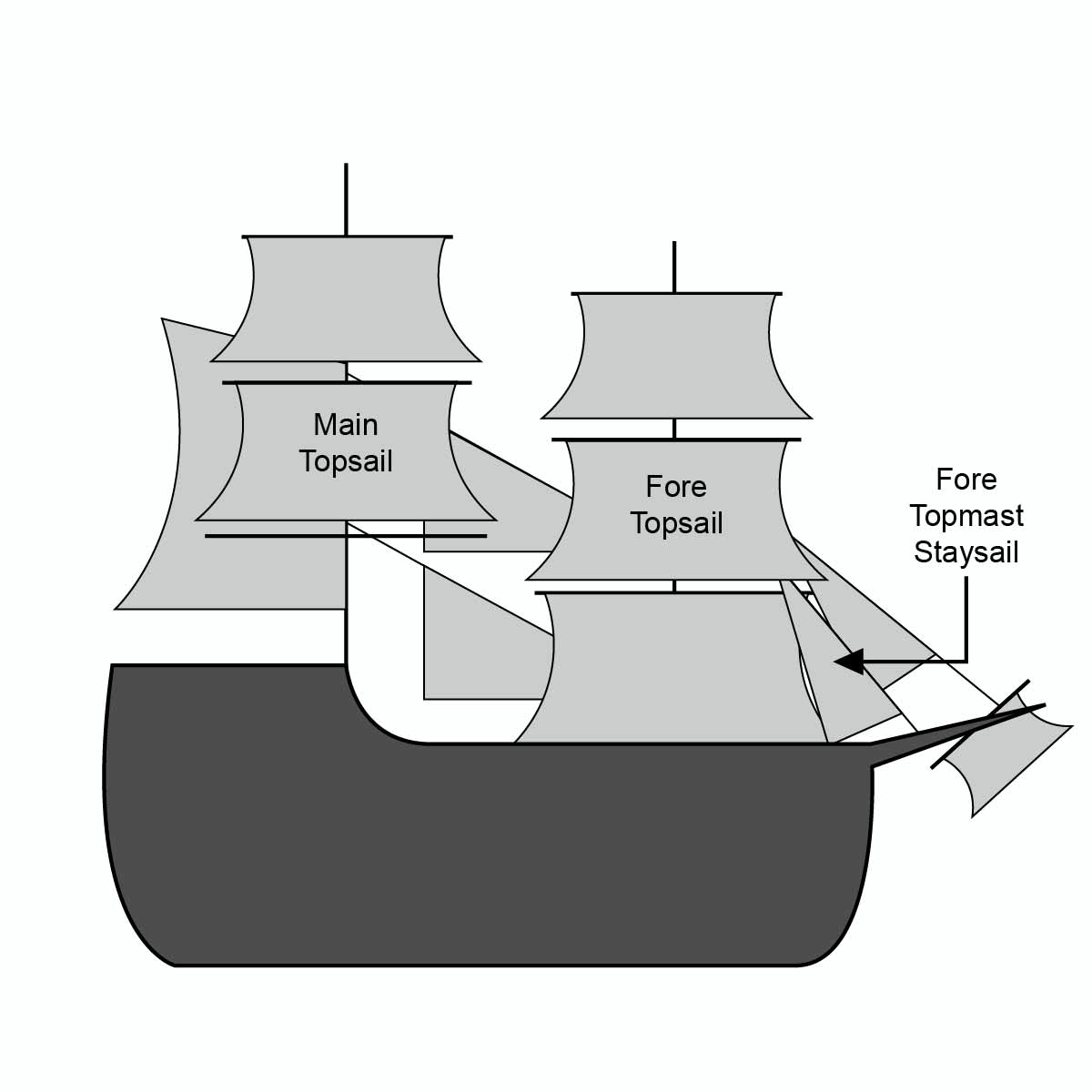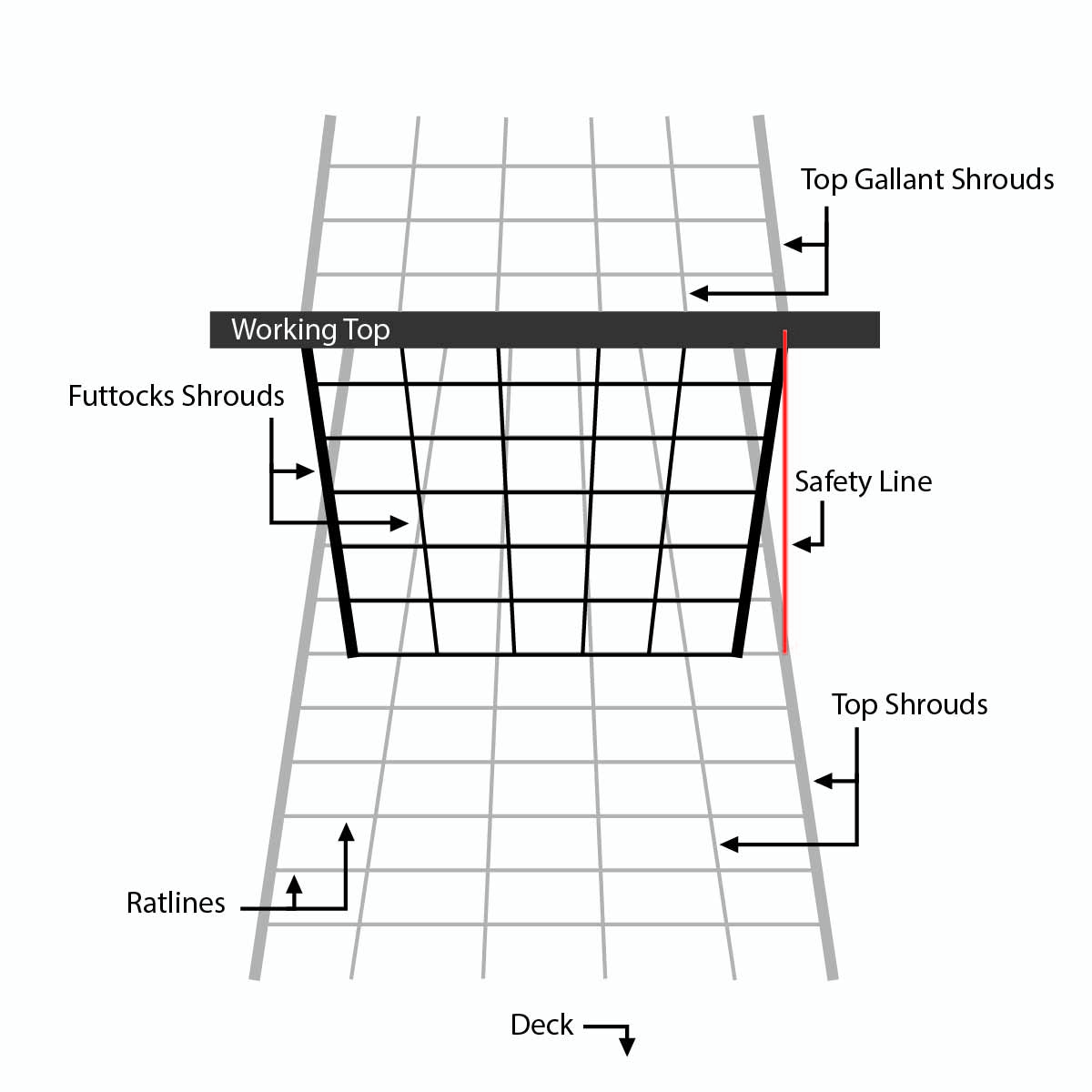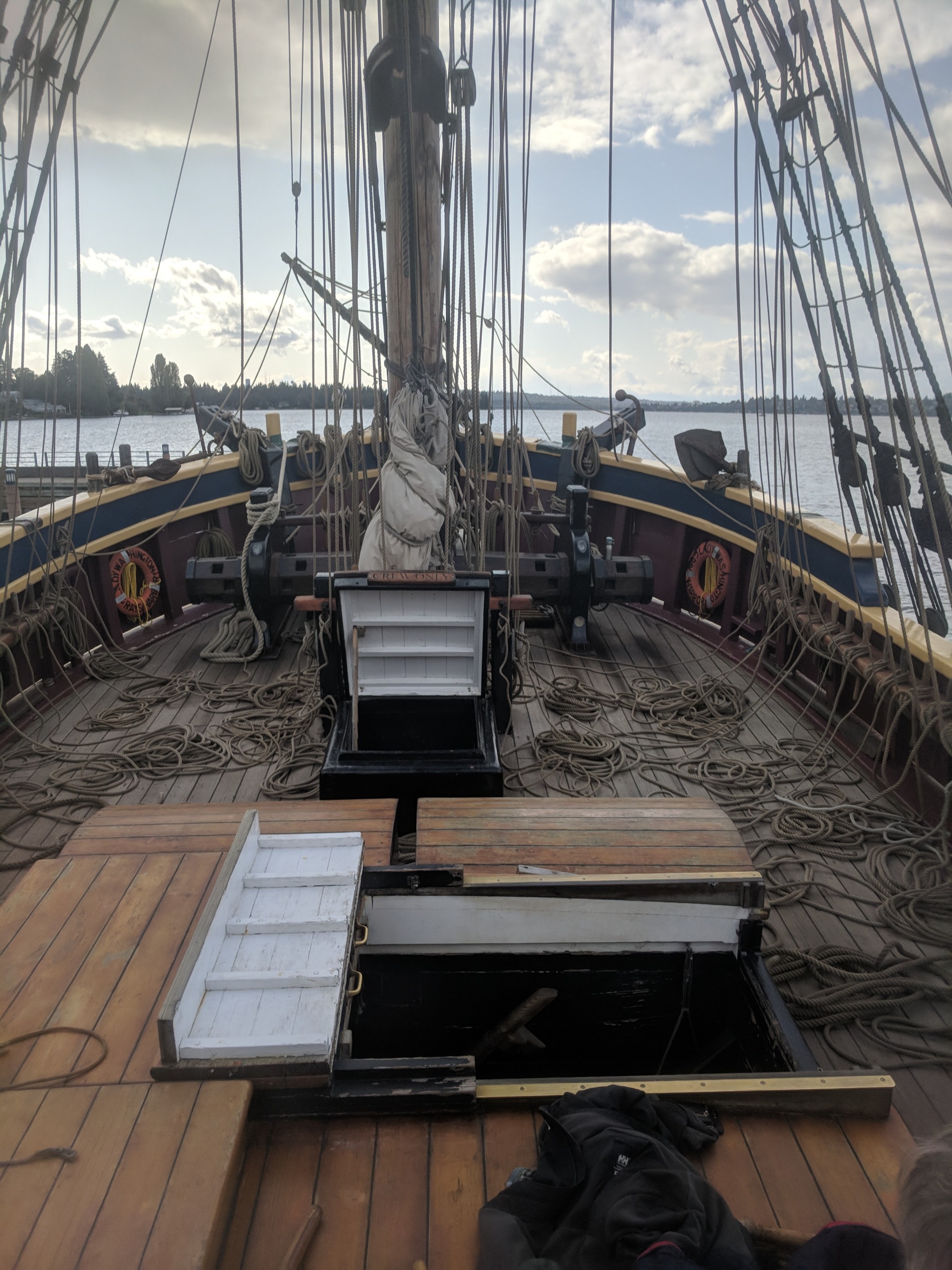This command sets the boat abuzz, sailors hurriedly pulling on their harnesses, double checking lanyards and pockets, making sure all marline spikes, sailing knives, and loose pieces of twine are secured to their person. It would be horribly embarrassing for a sailor to drop anything from aloft as it could hurt someone below, or heaven forbid, the boat itself.
A chorus of sailors reply, “Hands aloft to loose the fore top, main top, fore topm’st stays’l!”
This call and response is the instigator to our sail. It lets the captain know that we have heard him, as well as repeats the command for any crewmates who were distracted.
The captain has asked the crew to loose three of our most commonly used sails. The fore top and main top square sails sit on the second yard up from deck, the top yard. One is on the foremast and the other is on the mainmast. The fore topmast staysail is at the bow of the boat. It is a fore-and-aft sail, used to change the boat’s direction.

Figure 1 Lady Washington Sail Diagram, drawn by Sara Schall. Used with permission.
Sailors scatter. One heads out to the head rig to loose the foretopmast staysail. Two head over to the foremast. I and another of my shipmates head to the mainmast.
“Laying aloft on the main?” I ask for permission to begin my climb.
“Lay away,” the captain replies.
A shiver of anticipation runs through me. I step outside the safety of the railings, glad for my modern safety gear. I take my time as I climb the shrouds, placing my feet carefully on the ratlines, or rungs, of the big rope ladder that connects the deck to each of the working tops. I reach my first challenge, the futtocks. The futtocks are a set of shrouds that connect the top shrouds to the working top. A sailor must rely on their enhanced grip strength from months of hauling on lines, sanding blocks, and climbing in the rigging, in order to haul themselves up and over this outwards leaning section and onto the working top platform.
 Figure 2 Isometric Shroud Diagram. Photo by Sara Schall. Used with permission.
Figure 2 Isometric Shroud Diagram. Photo by Sara Schall. Used with permission.
Figure 4 Top Sail and Gear Diagram, drawn by Sara Schall. Used with permission.
“On safety,” I call to the sailor right below me. I let her know that I have attached myself to the safety line that connects the main shrouds to the working top and to wait until I have called, “Off safety,” for her to begin to tackle the futtocks. I pass over to the other side of the working top and half way up the second set of shrouds. I step out onto the foot rope hanging under the top yard.
“Laying out on the foot rope,” my partner calls, letting me know that there will be a shift of weight on the footrope. I work inboard to outboard while my partner shimmies along the yard outboard to inboard, undoing the gaskets that hold the sail to the yard. We are both clipped onto a metal rod, called the jackstay.
We pull the lines called gaskets around the yard into a cow hitch and then tie them up in a gasket coil behind the sail. This will keep them out of the way and easy to find when we pleat and roll the sails back into a furl. We both then head back to the center of the yard. The center of the sail is being held up in its furl by the buntline. In order to let loose the sail, one of us must reach around the mast and untie the hitch. Once we have the hitch ready to be released, we call down to deck, “On deck!”
“Aloft,” the captain responds, letting us know he can hear us.
“Main top loose to the bunt,” we call down.
The captain gives the order, “Let fall”.
“Let fall,” we answer, undoing the hitch fully to let the sail hang in its gear. One of us hitches the buntline back up, so it is also easy to find. We can now make our way back down.
“Laying off the footrope,” I say to my partner. I scurry back down the shrouds, cross back over the working top, and attach myself to the safety line once again.
“On safety,” I call. My partner responds in kind, so I know she has heard me.
“Back on deck, one on the main,” I yell, letting the captain know, not only that I am back on deck, but also that there is still one sailor aloft on the main mast.
Once all sailors are back on deck, we can finish setting sail.
(Because of my ship’s specific programing, the aloft and on deck portions of setting sail are far more separate than if we were not sailing for show. Back in the Age of Sail, speed was key. Each sailor had a specific task for every maneuver. For example, the smallest of the crew would be sent highest aloft as to lessen the weight burden on the rig. While those aloft were climbing down the shrouds, the on deck crew would already be at their lines ready to haul.)
The chief mate, acting as the captain’s mouthpiece, calls out, “Marry up your gear!” The deckhands repeat the command, making our way over to the set of three lines that are keeping the sail in a bunch, even if it is no longer tied onto the yard. The clews, buntlines, and reeflines are taken off of their individual pins and woven back onto the pin rail as a single group of three lines. This will make it easier to cast them later on.

Figure 4 Top Sail and Gear Diagram, drawn by Sara Schall. Used with permission.
“Hands to set the main top,” the chief mate commands. The sail I helped loose will now be pulled taut, allowing it to catch wind.
One sailor heads to the port side. Once he has taken the gear back off of the pin rail and has it gripped in his hand, he yells, “Ready port main tops’l gear!”
The sailor on the other side yells, “Ready starboard main tops’l gear!”
Two sailors each head over to the middle of the boat, to the pin rail directly in front of the main mast. I and another move to the front of the pin rail, taking all but the last turn of line off of the pin. We hold these lines, called sheets, tight, keeping tension on them until everyone is ready. The other two sneak behind the pin rail and grab onto the sheets from above. They will help haul on the sheets, while we take up slack, once the command is given.
When everyone is in position, we call out, “Ready port main tops’l sheet! Ready starboard main tops’l sheet!”
“Aye gear, aye sheets,” the chief mate lets us know she heard.
When everyone has called out their ready, the chief mate commands, “On the main, cast your gear; haul your sheets!”
At this command, a few things happen at once. The crew calls back, “Cast your gear, haul your sheets!” Those on the gear let their lines go, keeping them controlled so they do not hit anyone or get tangled, but otherwise running free. We, on the sheets, start hauling down, hand over hand, to take up slack. The sheets are connected to the corners of the sail. By hauling on them, we pull the sail completely out of its bundle and allow its trapezoidal shape to form.
In order to get all of the slack out of the line, our mate orders, “Sweat up starboard sheet, port sheet!”
The two sailors behind the pin rail are in for a treat and a great work out. They grab their lines, pushing forward, pulling back into a squatting position, and then forward/down to the pin. By creating this triangle with their bodies, they pull the last of the slack to the pin, while we, at the pin, take up on the line. We continue to take up as much slack as possible until the mate calls, “That’s well starboard! That’s well port!”
(Coincidently, this is where the phrase “don’t sweat the small stuff” comes from. Not only is it usually unnecessary to sweat smaller lines, since they can be tightened just by hauling, but it also puts undo strain on them.)
I make off my line to the pin, following a clockwise figure eight pattern, keeping my fingers out of the way so they do not get caught under the weight of the line’s tension. I then head over to the halyard and jump in line behind three other sailors.
Ahead of me, one sailor has hands on the vertical part of the halyard, while another has taken the halyard off of the pin to the last turn. The other sailors ahead of me have their hands on the line, ready to haul up slack.
We confirm that we are in position and the one at the pin yells to the chief mate, “Ready main tops’l halyard!”
She confirms and commands, “Aye main tops’l halyard! Haul your halyard!”
The person at the pin orders us, “Haul away!”
Our mate starts in, “Running down to Cuba with a load of sugar…” She sings this halyard shanty to keep us all in sync, hauling and taking up slack. The sailor at the vertical line of the halyard has the toughest job. Hand over hand, this line captain hauls downwards, squatting low in order to haul up the yard (haul yard à halyard).
“That’s well halyard,” the mate stops her song to yell, having watched the yard until it reached its peak. The sail is now fully spread out, pulled tight from the sheets below and the yard above, ready to harness the power of the wind.
The line captain calls out, “Dig in and hold!”
Those of us in line repeat back, “Dig in and hold” and hold tightly to the line so we do not lose what tension we just got or risk dropping the yard several feet, shocking the lines that keep it from falling to deck.
“Stopper’s on”, the line captain calls out. He has tied a stopping hitch onto the line, allowing those of us holding the line to release tension so that the sailor at the pin can make off the halyard.
In order to test the stopper, the line captain commands, “Two steps forward!”
We call back and take the two steps forward, bringing the line with us. The line captain carefully watches the hitch and line to see if anything shifts unfavorably.
The line captain, now certain the hitch will hold, calls out, “Stopper’s holding!”
The sailor at the pin then says, “Up behind, drop the line!” We repeat back to her and drop the line, giving her the slack to make off the halyard.
The stopper is released and the main topsail is set.
Following a similar process, the fore topsail and fore topmast staysail are pulled tight out of their furls in order to channel the wind.
Just as the crew settles in to coil down the spaghetti monster of lines lying all over the deck, the captain shouts, “All hands to brace around!” and off we scurry again.

Figure 5 Deck Spaghetti during Coiling Training. Photo credit: Nikolai Emke. Used with permission.
